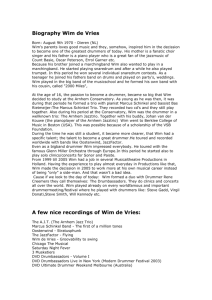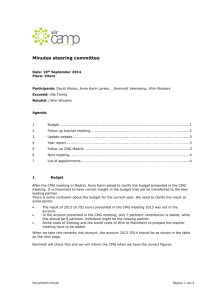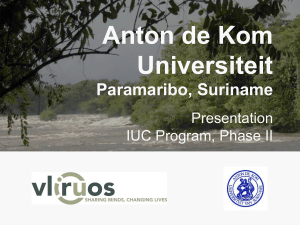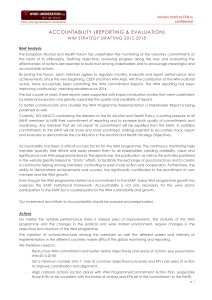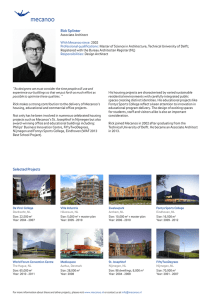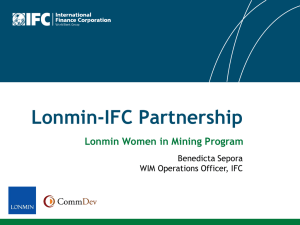file
advertisement
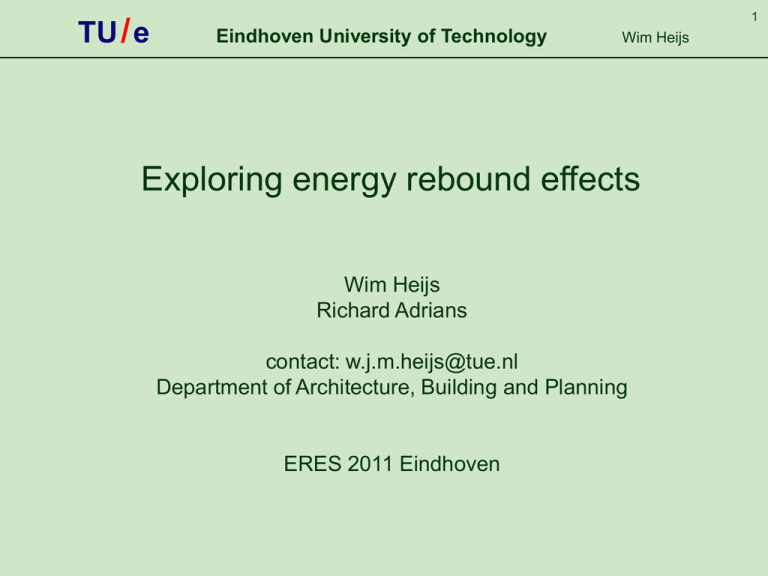
TU / e 1 Eindhoven University of Technology Wim Heijs Exploring energy rebound effects Wim Heijs Richard Adrians contact: w.j.m.heijs@tue.nl Department of Architecture, Building and Planning ERES 2011 Eindhoven TU / e 2 Eindhoven University of Technology Contents • Backgrounds • Rebound effects • Exploratory research • Conclusions Wim Heijs TU / e 3 Eindhoven University of Technology Wim Heijs Backgrounds: world energy production TU / e 4 Eindhoven University of Technology Wim Heijs Backgrounds: world electricity production TU / e 5 Eindhoven University of Technology Wim Heijs Backgrounds: household energy use Neth. household energy use Gj per person other sources natural gas (temp. corrected) electricity apparent stagnation despite technological and psychological efforts ... TU / e 6 Eindhoven University of Technology Wim Heijs Backgrounds: reasons for stagnation Real estate, e.g.: - quality of existing stock - investment, pay back time Occupants, e.g.: - knowledge - motivation, bad examples (industry, city) - strong habits, behavioral patterns rebound effects (or take back effects) TU / e 7 Eindhoven University of Technology Wim Heijs Rebound effect in general - energy efficiency measures - monetary savings - increased consumption (direct or indirect through production) - backfire: total elimination of saving (or worse) TU / e 8 Eindhoven University of Technology Wim Heijs Rebound effect: types - direct rebound effects: increased use when costs are lower e.g. higher room temperature, leave lights on, or take longer showers Wonderful, this new boiler! Now it takes twice as long before Norman gets angry... TU / e 9 Eindhoven University of Technology Wim Heijs Rebound effect: types - indirect rebound effects: opportunity to purchase new goods/services e.g. dryer, waterbed, more illumination indoors or in the garden... Don’t worry, dear. It’s energy efficient lighting! TU / e 10 Eindhoven University of Technology Wim Heijs Rebound effect: types - reinforced by marketing / technology push (especially electric appliances) Finally, you CAN afford the dryer you never had, AND save energy!!! TU / e 11 Eindhoven University of Technology Wim Heijs Exploratory research: existing studies - contradictory: estimated 1 - 80% (max. 170%) - large diversity of relevant behaviors many intervening factors - changes over time: longitudinal approach - problems concerning reliability TU / e 12 Eindhoven University of Technology Wim Heijs Exploratory research: design - limited time, opportunity (MSc R. Adrians) - to find indications while maximizing chance: most noticeable after significant change in energy use, move to a low energy dwelling - survey N=451, list of possible direct (30) and indirect (10) rebound effects controls: - no income change, drop energy costs - equal dwelling / household size - different energy-related features, etc. TU / e 13 Eindhoven University of Technology Wim Heijs Exploratory research: results - return rate 12% (N=54, holidays) - some controls unusable (hh / energy costs) unreliable answers, change of provider, no or dissimilar bills (no more natural gas, additional costs electricity heat pump, etc.) - others usable (income, situation) removed: changed household size (22), dwelling size, other intervening effects (11) - remaining for analyses: 21 cases TU / e 14 Eindhoven University of Technology Wim Heijs Exploratory research: main indicators - higher living room temperature night/day* 15/5 - more rooms heated simultaneously* 12 - higher temperatures when absent* 10 - computer / tv on longer 10/5 - increased number of lights indoors 7 - new freezer (not a replacement) 7 - more frequent use of dishwasher 6 - garden lighting on longer 6 - new garden lighting (not a replacement) 5 - more lights left on for security 5 - more frequent / longer showers 4/4 * to some extent natural / recommended d d d d d/i i d d i d d TU / e 15 Eindhoven University of Technology Wim Heijs Conclusions - provisional indications (in)direct rebound effects to some extent mitigated by ‘normal usage’ - low energy houses, energy-conscious people: more frequent in ‘normal’ population? - main lessons learned: > control intervening factors very difficult > statistical correction of situational differences using large samples > longitudinal design, objective measures TU / e 16 Eindhoven University of Technology Wim Heijs Conclusions - rebound effects plausible, inevitable - partly responsible for slow progress - disregard: transformation of problems instead of solution - difficult to prevent, inherent to economy - awareness necessary first step - research on prevalence, strategies - what about larger users (industry, government)? - renewable sources the only real way out? TU / e 16 Eindhoven University of Technology Thank you for your attention Questions and discussion... Wim Heijs



